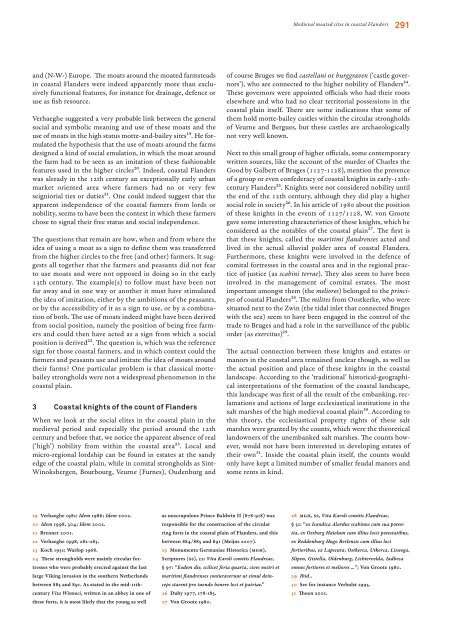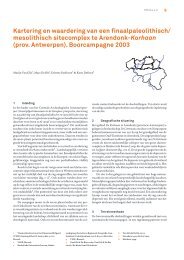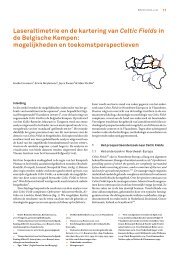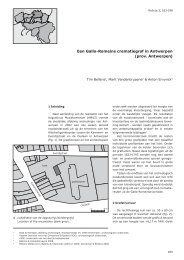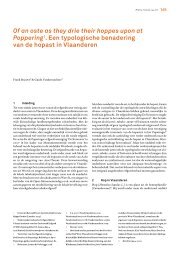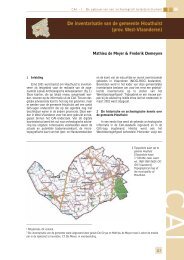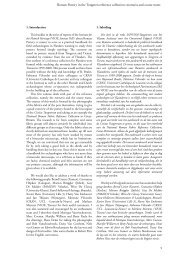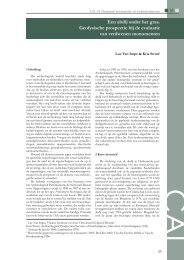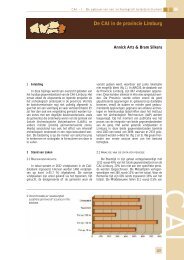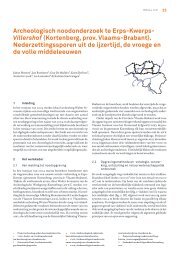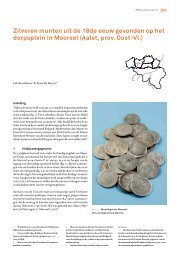Exchanging Medieval Material Culture Studies on archaeology and ...
Exchanging Medieval Material Culture Studies on archaeology and ...
Exchanging Medieval Material Culture Studies on archaeology and ...
Create successful ePaper yourself
Turn your PDF publications into a flip-book with our unique Google optimized e-Paper software.
<strong>and</strong> (N-W-) Europe. Th e moats around the moated farmsteads<br />
in coastal Fl<strong>and</strong>ers were indeed apparently more than exclusively<br />
functi<strong>on</strong>al features, for instance for drainage, defence or<br />
use as fi sh resource.<br />
Verhaeghe suggested a very probable link between the general<br />
social <strong>and</strong> symbolic meaning <strong>and</strong> use of these moats <strong>and</strong> the<br />
use of moats in the high status motte-<strong>and</strong>-bailey sites19. He formulated<br />
the hypothesis that the use of moats around the farms<br />
designed a kind of social emulati<strong>on</strong>, in which the moat around<br />
the farm had to be seen as an imitati<strong>on</strong> of these fashi<strong>on</strong>able<br />
features used in the higher circles20. Indeed, coastal Fl<strong>and</strong>ers<br />
was already in the 12th century an excepti<strong>on</strong>ally early urban<br />
market oriented area where farmers had no or very few<br />
seigniorial ties or duties21. One could indeed suggest that the<br />
apparent independence of the coastal farmers from lords or<br />
nobility, seems to have been the c<strong>on</strong>text in which these farmers<br />
chose to signal their free status <strong>and</strong> social independence.<br />
Th e questi<strong>on</strong>s that remain are how, when <strong>and</strong> from where the<br />
idea of using a moat as a sign to defi ne them was transferred<br />
from the higher circles to the free (<strong>and</strong> other) farmers. It suggests<br />
all together that the farmers <strong>and</strong> peasants did not fear<br />
to use moats <strong>and</strong> were not opposed in doing so in the early<br />
13th century. Th e example(s) to follow must have been not<br />
far away <strong>and</strong> in <strong>on</strong>e way or another it must have stimulated<br />
the idea of imitati<strong>on</strong>, either by the ambiti<strong>on</strong>s of the peasants,<br />
or by the accessibility of it as a sign to use, or by a combinati<strong>on</strong><br />
of both. Th e use of moats indeed might have been derived<br />
from social positi<strong>on</strong>, namely the positi<strong>on</strong> of being free farmers<br />
<strong>and</strong> could then have acted as a sign from which a social<br />
positi<strong>on</strong> is derived22. Th e questi<strong>on</strong> is, which was the reference<br />
sign for those coastal farmers, <strong>and</strong> in which c<strong>on</strong>text could the<br />
farmers <strong>and</strong> peasants use <strong>and</strong> imitate the idea of moats around<br />
their farms? One particular problem is that classical mottebailey<br />
str<strong>on</strong>gholds were not a widespread phenomen<strong>on</strong> in the<br />
coastal plain.<br />
3 Coastal knights of the count of Fl<strong>and</strong>ers<br />
When we look at the social elites in the coastal plain in the<br />
medieval period <strong>and</strong> especially the period around the 12th<br />
century <strong>and</strong> before that, we notice the apparent absence of real<br />
(‘high’) nobility from within the coastal area23. Local <strong>and</strong><br />
micro-regi<strong>on</strong>al lordship can be found in estates at the s<strong>and</strong>y<br />
edge of the coastal plain, while in comital str<strong>on</strong>gholds as Sint-<br />
Winoksbergen, Bourbourg, Veurne (Furnes), Oudenburg <strong>and</strong><br />
19 Verhaeghe 1981; Idem 1986; Idem 2002.<br />
20 Idem 1998, 304; Idem 2002.<br />
21 Brenner 2001.<br />
22 Verhaeghe 1998, 282-283.<br />
23 Koch 1951; Warlop 1968.<br />
24 Th ese str<strong>on</strong>gholds were mainly circular fortresses<br />
who were probably erected against the last<br />
large Viking invasi<strong>on</strong> in the southern Netherl<strong>and</strong>s<br />
between 885 <strong>and</strong> 891. As stated in the mid-11thcentury<br />
Vita Winnoci, written in an abbey in <strong>on</strong>e of<br />
these forts, it is most likely that the young as well<br />
as unscrupulous Prince Baldwin II (878-918) was<br />
resp<strong>on</strong>sible for the c<strong>on</strong>structi<strong>on</strong> of the circular<br />
ring forts in the coastal plain of Fl<strong>and</strong>ers, <strong>and</strong> this<br />
between 884/885 <strong>and</strong> 891 (Meijns 2007).<br />
25 M<strong>on</strong>umenta Germaniae Historica (mgh),<br />
Scriptores (ss), 12: Vita Karoli comitis Fl<strong>and</strong>riae,<br />
§ 97: “Eodem die, scilicet feria quarta, cives nostri et<br />
maritimi fl <strong>and</strong>renses c<strong>on</strong>iuraverunt ut simul deinceps<br />
starent pro tuendo h<strong>on</strong>ere loci et patriae.”<br />
26 Duby 1977, 178-185.<br />
27 V<strong>on</strong> Groote 1980.<br />
<str<strong>on</strong>g>Medieval</str<strong>on</strong>g> moated sites in coastal Fl<strong>and</strong>ers 291<br />
of course Bruges we fi nd castellani or burggraven (‘castle governors’),<br />
who are c<strong>on</strong>nected to the higher nobility of Fl<strong>and</strong>ers24.<br />
Th ese governors were appointed offi cials who had their roots<br />
elsewhere <strong>and</strong> who had no clear territorial possessi<strong>on</strong>s in the<br />
coastal plain itself. Th ere are some indicati<strong>on</strong>s that some of<br />
them hold motte-bailey castles within the circular str<strong>on</strong>gholds<br />
of Veurne <strong>and</strong> Bergues, but these castles are archaeologically<br />
not very well known.<br />
Next to this small group of higher offi cials, some c<strong>on</strong>temporary<br />
written sources, like the account of the murder of Charles the<br />
Good by Galbert of Bruges (1127-1128), menti<strong>on</strong> the presence<br />
of a group or even c<strong>on</strong>federacy of coastal knights in early-12thcentury<br />
Fl<strong>and</strong>ers25. Knights were not c<strong>on</strong>sidered nobility until<br />
the end of the 12th century, although they did play a higher<br />
social role in society26. In his article of 1980 about the positi<strong>on</strong><br />
of these knights in the events of 1127/1128, W. v<strong>on</strong> Groote<br />
gave some interesting characteristics of these knights, which he<br />
c<strong>on</strong>sidered as the notables of the coastal plain27. Th e fi rst is<br />
that these knights, called the maritimi fl <strong>and</strong>renses acted <strong>and</strong><br />
lived in the actual alluvial polder area of coastal Fl<strong>and</strong>ers.<br />
Furthermore, these knights were involved in the defence of<br />
comital fortresses in the coastal area <strong>and</strong> in the regi<strong>on</strong>al practice<br />
of justice (as scabini terrae). Th ey also seem to have been<br />
involved in the management of comital estates. Th e most<br />
important am<strong>on</strong>gst them (the meliores) bel<strong>on</strong>ged to the principes<br />
of coastal Fl<strong>and</strong>ers28. Th e milites from Oostkerke, who were<br />
situated next to the Zwin (the tidal inlet that c<strong>on</strong>nected Bruges<br />
with the sea) seem to have been engaged in the c<strong>on</strong>trol of the<br />
trade to Bruges <strong>and</strong> had a role in the surveillance of the public<br />
order (as exercitus)29.<br />
Th e actual c<strong>on</strong>necti<strong>on</strong> between these knights <strong>and</strong> estates or<br />
manors in the coastal area remained unclear though, as well as<br />
the actual positi<strong>on</strong> <strong>and</strong> place of these knights in the coastal<br />
l<strong>and</strong>scape. According to the ‘traditi<strong>on</strong>al’ historical-geographical<br />
interpretati<strong>on</strong>s of the formati<strong>on</strong> of the coastal l<strong>and</strong>scape,<br />
this l<strong>and</strong>scape was fi rst of all the result of the embanking, reclamati<strong>on</strong>s<br />
<strong>and</strong> acti<strong>on</strong>s of large ecclesiastical instituti<strong>on</strong>s in the<br />
salt marshes of the high medieval coastal plain30. According to<br />
this theory, the ecclesiastical property rights of these salt<br />
marshes were granted by the counts, which were the theoretical<br />
l<strong>and</strong>owners of the unembanked salt marshes. Th e counts however,<br />
would not have been interested in developing estates of<br />
their own31. Inside the coastal plain itself, the counts would<br />
<strong>on</strong>ly have kept a limited number of smaller feudal manors <strong>and</strong><br />
some rents in kind.<br />
28 mgh, ss, Vita Karoli comitis Fl<strong>and</strong>riae,<br />
§ 51: “ex Is<strong>and</strong>ica Alardus scabinus cum sua potentia,<br />
ex Ostburg Haiolum cum illius locis potestatibus,<br />
ex Reddenburg Hugo Berlensis cum illius loci<br />
fortioribus, ex Lapscura, Ostkerca, Utkerca, Liswega,<br />
Slipen, Gistella, Oldenburg, Lichtervelda, Iadbeca<br />
omnes fortiores et meliores ...”; V<strong>on</strong> Groote 1980.<br />
29 Ibid..<br />
30 See for instance Verhulst 1995.<br />
31 Th oen 2001.


